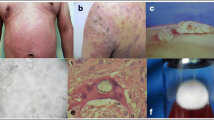Abstract
The principal ultrastructural changes in cells of Candida albicans treated with amphotericin B (AmB), either in vitro or in vivo, and in the presence or absence of prednisolone included plasmolysis, vacuolation and destruction of organelles. Lamination of the cell wall, although discernible after 4 h antibiotic treatment in vitro, was conspicuous in vivo, especially in prednisolone-treated mice given AmB 72 h after inoculation and was seen in both phagocytosed cells and those free in inflammatory exudates. Somatic extracts from control cells and somatic extracts and leachates from AmB-treated cells showed the presence of low-grade toxic components when given i.p. to mice receiving actinomycin D(AMD) s.c. Culture filtrates were negative. Eighteen hour cultures were more toxic than those grown for 3 days and no toxicity was shown for cultures after 8 or 14 days. The behaviour of toxic materials during electrophoresis in polyacrylamide gels suggested that they were proteins of relatively high molecular weight.
Similar content being viewed by others
References
Bakerspigel, A. 1964. Some observations on the cytology of Candida albicans. J. Bact. 87: 228–230.
Blyth, W. & Stewart, Gwendoline E. 1978. Systemic candidiasis in mice treated with prednisolone and amphotericin B. 1. Morbidity, mortality and inflammatory reaction. Mycophathologia.
Chattaway, F.W., Odds, F.C. & Barlow, A.J.E. 1971. An examination of the production of hydrolytic enzymes and toxins by pathogenic strains of Candida albicans. J. gen. Microbiol. 67: 255–263.
Denning, T.J.Y. & Davies, R.R. 1973. Candida albicans and the chemotaxis of polymorphonuclear neutrophils. Sabouraudia 11: 210–221.
Gale, E.F., Johnson, Alison M., Kerridge, D. & Koh, T.Y. 1975. Factors affecting the changes in amphotericin sensitivity of Candida albicans during growth. J. gen. Microbiol. 87: 20–36.
Gale, G.R. 1963. Cytology of Candida albicans as influenced by drugs acting on the cytoplasmic membrane. J.Bact. 86: 151–157.
Hammond, S.M. & Kliger, B.N. 1974. Studies on the role of the cell wall of Candida albicans in the mode of action of polyene antibiotics. Proc. Soc. Gen. Microbiol. 1: 45.
Isenberg, H.D., Allerhand, J. & Berkman, J. 1963. An endotoxin-like fraction extracted from the cells of Candida albicans. Nature, London. 197: 516–517.
Iwata, K. & Uchida, K. 1967. ‘Canditoxin’ 2. Isolation and purification of the toxic substance. Medicine and Biology (Tokyo) 74: 351–356.
Iwata, K., Uchida, K., Yamaguchi, H. & Nozu, Y. 1972. Studies on the toxins produced by Candida albicans with special reference to their etiopathological role. ‘Yeasts and Yeast-like Microorganisms in Medical Science’, (ed. Iwata, K.) pp. 184–190. University of Tokyo Press.
Kobayshi, G.S. & Friedman, L. 1964. Characterization of the pyrogenicity of Candida albicans, Saccharomyces cerevisiae and Cryptococcus neoformans. J. Bact. 88: 660–666.
Lampen, J.O. 1966. Interference by polyenic fungal antibiotics (especially nystatin and filipin) with specific membrane functions. Symp. Soc. gen. Microbiol. 16: 111–130.
Montes, L.F., Patrick, T.A., Martin, S.A. & Smith, M. 1965. Ultrastructure of blastospores of Candida albicans after permanganate fixation. J. invest. Derm. 45: 227–232.
Montes, L.F. & Wilborn, W.H. 1968. Ultrastructural features of hostparasite relationship in oral candidiasis. J. Bact. 96: 1349–1356.
Mourad, S. & Friedman, L. 1961. Pathogenicity of Candida. J. Bact. 81: 550–556.
Müller, J., Douchet, C. & Sukuma, S. 1972. Electron microscopic studies on the host-parasite relationship of the experimental Candida albicans infection of the mouse: the Candida granuloma in the kidney. ‘Yeasts and Yeast-like Microorganisms in Medical Science’, (ed. Iwata, K.) pp. 178–183. University of Tokyo Press.
Partridge, Betty M. & Drew, J. Anne. 1974. Candida protoplasts and their ultrastructure. Sabouraudia 12: 166–178.
Pieroni, R.E. & Levine, L. 1970. Use of actinomycin D for quantitation of endotoxins in Pertussis vaccine and extracts. Symp. Series Immunobiol. Standard. 13: 198–202.
Polak, A. & Scholer, H.. 1976. Combination of amphotericin B and 5-fluorocytosine. Chemotherapy 6: 137–142.
Salvin, S.B. 1952. Endotoxin in pathogenic fungi. J. J. Immun. 69: 89–99.
Winner, H.I. 1956. Immunity in experimental moniliasis. J. Path. Bact. 71: 234–237.
Author information
Authors and Affiliations
Rights and permissions
About this article
Cite this article
Blyth, W., Stewart, G.E. Systemic candidiasis in mice treated with prednisolone and amphotericin B. 2. Ultrastructure and evidence for fungal toxin. Mycopathologia 66, 51–57 (1978). https://doi.org/10.1007/BF00429593
Issue Date:
DOI: https://doi.org/10.1007/BF00429593




